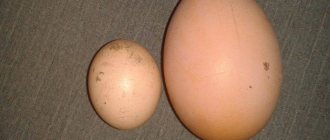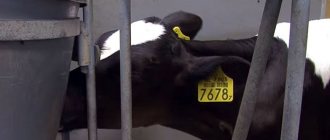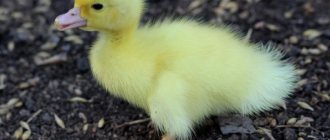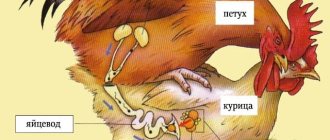Symptoms of the disease
Paralysis of the limbs is quite difficult to detect at the initial stage of development. There are certain signs by which you can clearly understand that the rabbit’s limbs will soon be paralyzed:
- It becomes difficult for the animal to walk.
- The limbs diverge and do not obey the animal.
- The rabbit becomes lethargic.
- Every movement is accompanied by pain. This can be detected by grinding of teeth or slight tremors.
During treatment, you need to provide comfort and warmth. It is necessary to place the rabbit in an individual cage, as there is a danger of an infectious origin of the disease. If you do not remove the rabbit, the infection can spread and cause the death of all individuals that were in contact with the animal.
The course of the disease often becomes unpredictable. If the animal's condition worsens, the following signs appear:
- formation of bedsores (occasionally paws become bald);
- problems with urination;
- diarrhea;
- thirst;
- heavy salivation;
- disorientation.
The disease can also affect the central nervous system. Because of this, the development of the disease becomes difficult to predict. Most often, the intervention of specialists does not provide the desired effect, and the rabbit dies. If you provide help in time, there is a chance to save the animal.
Important! Paralysis associated with central nervous system problems requires long-term treatment and the use of expensive drugs.
Encephalozoonosis affects the brain.
Paralysis of the hind legs can occur with encephalozoonosis. Maybe, but not necessarily. Often rabbits are simply carriers of the disease without showing symptoms. The disease is caused by the parasite Encephalitozoon cuniculi, which in Russian sounds like Rabbit Encephalitozoon.
The single-celled parasite settles in the kidney and nervous tissues of the brain and spinal cord of infected rabbits, destroying them and inhibiting certain functions. Sometimes it is found in other organs, such as the heart, lungs, liver and spleen (the symptoms will be different accordingly). It is quite difficult to detect this infection. A biopsy (removal of body parts for examination) of the kidneys, brain or other organs poses certain risks and is usually not financially feasible. However, the presence of the parasite can be determined through a blood test for the presence of antibodies against the microsporidia parasite. The peculiarity of this test is that it is not completely reliable and only shows that the rabbit was once infected and does not necessarily indicate an active infection. Studies have shown that a healthy rabbit can have these antibodies, because they persist for life. On the other hand, with a long-term illness, they may disappear from the blood altogether. Therefore, veterinarians often do testing twice, with a break of 10-14 days. An increase in antibody concentration clearly indicates the progression of the parasite and the need to prescribe a course of treatment.
IF IT IS very problematic to IDENTIFY Encephalitozoon cuniculi in a living rabbit, because a blood test for the presence of antibodies does not guarantee reliability, then a veterinarian can take any part of the body from a dead rabbit for examination and say for sure whether there is a parasite in it or not (or what other one he will find).
SOME RABBIT HEATERS confuse encephalozoonosis with encephalitis. But these are completely different diseases. The latter is viral in nature and is transmitted by encephalitis ticks, which live mainly in Siberia, Transbaikalia, and the Far East. By the way, even an ordinary dog tick, when attached to a rabbit, can cause paralysis of the limbs. As a rule, after its removal, rabbits restore lost functions.
The insidiousness of the disease lies in the fact that it can lie low and not manifest itself for a long time, but capture increasingly larger areas of the body. The zoonotic rabbit itself is a source of infection for the entire herd, since for the time being, all rabbits are outwardly active, eat well and even mate.
| Subscribe to our website's weekly newsletters: Current notes on keeping rabbits are waiting for you. SUBSCRIBE |
Basically, rabbits become infected from each other through direct contact, through the placenta during childbirth, natural secretions, through spores found in contaminated feed and carried not only by rabbits, but also by rodents and birds. Most often, the disease is brought into the farm with newly purchased rabbits, in which the disease is not so pronounced. If signs of encephalozoonosis appear, it is necessary to isolate sick rabbits, prevent the rest, clean and burn all cages. There are no chemicals that are guaranteed to kill the parasite yet, and the disease itself has not been fully studied.
Rabbits are treated with Fenbendazole 20 mg/kg once daily for 4 weeks. As a rule, after this course, antibodies to E. cuniculi are no longer detected in the blood. Panacur, containing the above-mentioned active substance, is also used. Dexamethasone can be used to reduce swelling of brain tissue. The results of treatment strongly depend on both the stage of development of the disease and the rabbit’s body itself. Sometimes the immune system copes on its own without the intervention of drugs, producing a sufficient amount of antibodies.
In some cases, symptoms other than partial paralysis are observed. For example, when a rabbit trembles, moves unsteadily, falls to the side, twists its head, the so-called torticollis.
Torticollis MAY also have a different nature, for example associated with otitis media. Doctors advise defining it this way: if the eyeball moves randomly horizontally, then there is a problem with the ears; if vertically, then there is encephalozoonosis. In the latter case, an autopsy reveals kidney damage.
In conclusion, I will try to reassure you a little and say that despite the danger of this disease, it is not very common on farms. Even when he appears in them, he doesn’t mow down everyone. The vast majority of rabbits suppress the unlimited development of microsporidia, a parasite, with their immune system throughout their lives. But it is still worth identifying it and fighting it, otherwise rabbits with crooked necks, paralysis, blindness and other bad signs will appear on your farm from time to time.
Causes of paralysis
When paralyzed, the animal cannot rise; it tries to move using its forelimbs. The rear ones, at this time, stretch like ballast. Sometimes paralyzed animals take an unusual position when moving and fall to one side. This is a serious disease that requires immediate diagnosis.
Causes of paralysis:
- Injuries.
- CNS disorders.
- Listeriosis.
- Constipation or diarrhea.
- Inflammation of the brain.
- Lack of calcium.
- Other reasons
It is important to understand how each of these conditions can cause paralysis of a rabbit's hind legs. Let's consider each of them separately.
Injuries
Trauma is the most common cause of hind limb paralysis in rabbits. A broken spine can lead to this. When the integrity of the vertebrae is compromised, the nerves connecting the brain to the limbs are damaged. The result is paralysis. This is caused not only by spinal injuries, but also by other injuries:
- Brain concussion.
- Pinched nerves as a result of destruction of the vertebrae or their deformation (this occurs in older animals).
If you find that an animal's hind legs have been taken away, you should not make hasty conclusions about the causes of paralysis. The animal should be shown to a veterinarian. An x-ray will be required to make a diagnosis. It is important to confirm or exclude head or spinal injury.
Disturbance in the functioning of the central nervous system
If there are malfunctions in the functioning of the central nervous system and the part of the brain responsible for the sensitivity of the paws is affected, then the hind limbs can be paralyzed. Rabbits are very shy. Therefore, noise and stress can lead to brain disorders.
If paralysis occurs due to stress, there is a high probability that some sensation in the paws will be preserved. This means that the rabbit's health can be restored. With proper treatment this will take approximately a week.
Listeriosis
In rabbits, the most dangerous cause of paralysis is listeriosis. The onset of this disease is associated with the spread of infection by rabbits, insects, rodents, and wild animals.
Rabbits become infected with listeriosis through contact with infected animals. In addition, their feces are also dangerous. With this disease, treatment is pointless. In its acute form, the disease can affect the weakest animals. Young animals become ill more often, after which they also die. Moreover, death occurs very quickly.
There is also a chronic form of the disease. Infected rabbits can live with it for up to 1 month. However, in any case, the animal will face death.
Listeriosis is easy to recognize when examined by a veterinarian. In addition to paralysis, there are often other signs: infected animals have enlarged spleens and affected livers. In 95% of cases of listeriosis infection in rabbits, spasms are present.
If a rabbit has lost its hind legs due to listeriosis, it is unlikely to recover. The spread of this disease is difficult to predict. A sick rabbit should be quarantined. You also need to know how to properly dispose of a dead carcass. We need to bury it away from the farm or burn it.
Constipation or diarrhea
Digestive disorders can cause a rabbit's hind legs to become paralyzed. If you find diarrhea in your rabbit, then you need to understand that the pet is losing a lot of fluid. Because of this, the blood thickens, blood circulation is impaired, and as a result, the hind legs stop working.
Important! Diarrhea causes toxins to accumulate in the body. They can affect the functioning of the central nervous system and cause paralysis.
Brain replenishment
The brain is an organ responsible for the functioning of many systems. Its proper operation allows it to respond to some external and internal factors. The scope of brain activity also includes physical activity. Any failure of this organ can lead to death.
Inflammation in the brain can cause paralysis of the paws. Most often, paralysis is a consequence of such diseases:
- Encephalitis.
- Encephalomyelitis.
- Meningitis.
It is best to ask your veterinarian what to do when signs of inflammation appear. Breeders recommend abandoning attempts to save the life of a paralyzed animal, since the likelihood of a full recovery is minimal.
Before taking extreme measures, you should take your sick rabbit to the veterinarian. It is possible that the paralysis will be a disorder of the central nervous system. Medicines can put an animal back on its paws in 5-7 days if the breeder contacts a specialist in time.
The body does not receive the required amount of calcium
If a rabbit's diet is unbalanced and it lacks calcium, it may develop paralysis of its hind legs. If there is a lack of calcium, the body obtains it from the bones. This can lead to delayed skeletal formation and brittle bones. Artificially fed rabbits are at greater risk. Deficiency can also be caused by feeding foods that leach calcium from the body: beets, spinach, and some grains.
Other reasons
If a rabbit is deficient in vitamin B, many nervous pathologies appear in the body due to a decrease in impulses. This is one of the main causes of paralysis.
In diseases that affect the lungs, oxygen deficiency occurs, which causes interruptions in the cardiovascular system. Because of this, the limbs do not receive enough blood, the muscles become weak. Therefore, the rabbit is unable to stand on its feet and constantly falls.
Serious infections, for example, coccidiosis and pasteurellosis, favor the release of toxic substances into the blood. Because of this, intoxication occurs, brain function is interrupted and muscles weaken.
Rabbits can develop pseudoparalysis. It is not true paralysis. The limbs are still sensitive, but the animal does not get up. This happens because the rabbit feels pain. Pseudoparalysis develops due to overheating.
Injuries
Another good reason why ewes, rams and lambs do not stand on their hind legs is the injuries they have received.
The main injuries in these animals are:
- Chemical injuries. They arise due to the possible impact on the body of sheep of acids, alkalis and toxic substances. As a result, livestock may suffer burns and general body poisoning. As a result, the animal may fall and not have the strength to rise.
- Physical injuries. Occur due to exposure of livestock to high or low temperatures, electric current or ultraviolet radiation. Usually they can manifest themselves in the form of burns, frostbite and radiation sickness. As a result of this impact, the animal weakens, it becomes difficult for him to get up and sit down.
- Mechanical injuries. They occur when organs are exposed to mechanical force during falls, collisions with vehicles, or damage from sharp objects. Such injuries are characterized by bruises, fractures, sprains and wounds. In this case, it is necessary to carefully examine the animal and, if necessary, apply a fixing or plaster bandage to the sheep’s limb.
What should a breeder do if paralysis is detected?
If symptoms are detected, the breeder must act quickly. Every hour can be critical, so you should immediately get qualified professional help.
Do not treat yourself; this will not give positive results, but will only lead to deterioration of the animal’s health and death. The cause of paralysis can only be determined if the animal breaks its leg. This will become clear from his behavior and appearance. In addition, a fracture rarely occurs on both paws at once, which makes it easy to understand whether a fracture has occurred or the limbs have become paralyzed. In any case, only a doctor can determine the exact cause. Don't delay asking for help.
First of all, the breeder must isolate the animal from external stimuli. It needs to be placed in a separate cage, creating warmth and silence. If the animal still tries to use the injured leg, this is a good sign. The rabbit reaches the equipment in the cage, hits the bed and behaves unnaturally due to anxiety. Physical activity indicates the presence of pain due to injury or pinched nerve.
Spondylosis
This disease is typical for females older than four years. Spondylosis is a dystrophic disease that deforms bone tissue, accompanied by growths in the form of bone spines and tubercles. As a result, chronic pain reactions develop, narrowing of the spinal canal and impaired conduction of nerve impulses to the limbs. In rabbits, spondylosis of the lumbar skeleton is especially distinguished. The disease is aggravated by excess weight, inactivity of the animal and everything associated with the manifestation of aging of the body. The unpleasant thing is that gradually the rabbit begins to experience pain, stops defecating normally, and finally, its paws may fail. The disease progresses slowly, the rabbit will die faster than the pathogenesis will develop to its full potential.
Treatment. Palliative hormone therapy. Dexamethasone in a dose of 0.3 ml IM once every 7 days. Or in severe cases, Kenalog in the same dose once a month. You can try aspirin, but use it carefully; it sometimes causes side effects when combined with antibiotics. As antimicrobial agents, you can use a veterinary analogue of bicillin, Vetbitsin-3 or Vetbitsin-5 at a dose of 10-30 mg/per animal.
Prevention. A good remedy is to create conditions for a good quality of life. This includes professional massage, acupuncture, and dietary nutrition.
How to treat a rabbit?
Before calling a doctor or going to the clinic, you need to give your rabbit first aid:
- Place the rabbit in a dark cage to reduce fear.
- Next, you need to go to the clinic and perform an x-ray examination.
If damage to the spine is discovered during the examination, doctors will prescribe anti-inflammatory therapy, painkillers and physical therapy. The breeder will need to massage the rabbit and change diapers. Also, the owner of a rabbit can purchase a device that allows the animal to move independently. During rehabilitation, a special therapeutic and preventive diet must be maintained. It should contain sufficient amounts of minerals, vitamins and fiber.
If listeriosis is detected in a rabbit, the animal must be immediately removed from the common cage to prevent infection of others. Unfortunately, treatment for this disease does not bring the desired result. Treatment is possible, but not advisable, since recovering rabbits continue to spread the infection and are no longer able to reproduce.
If an animal near its owner becomes ill with pododermatitis, the veterinarian will prescribe antibacterial therapy and rehabilitation. Antiseptic ointments or sprays are also used. In addition, it is necessary to carry out general cleaning of the cage weekly.
Associated symptoms
If a rabbit from an industrial herd has lost its hind legs, it is slaughtered, but the owners try to treat a decorative pet living in an apartment. The following symptoms occur:
- Bedsores form.
- The resulting skin defects rot.
- The innervation of the urogenital organs is disrupted. Incontinence develops. Urine constantly leaks out in small portions.
- The nervous regulation of the alimentary tract is distorted, which leads to involuntary bowel movements and diarrhea.
- The rabbit is constantly thirsty.
- Excessive salivation develops.
- The combination of movements is disrupted, the rabbit lies in an unnatural position.
- From time to time the body is shaken by convulsions.
In the clinic
Preventive measures
Prevention will help minimize the possibility of developing paralysis. Follow these guidelines to protect your rabbit from illness:
- Visit your veterinarian for an examination.
- Maintain your diet. A rabbit's diet should be rich in fiber, vitamins and minerals.
- Keep the animal in a clean cage. Keep the cage, tray and feeder clean regularly.
- Do not leave your pet alone to avoid injury.
- You must keep your rabbit calm. Do not frighten the animal; it should not feel afraid or stressed.
- If children come into contact with the animal, make sure that their games do not harm the pet.
Stress and shock provoke limb failure.
Everyone knows that rabbits are very shy animals. Even in the wild, they try not to stray too far from their burrows. In the event of a sudden danger, they may experience not only fear, but also extreme measures of its manifestation, such as stress and shock. It turns out that in this state the rabbit may lose the ability to move normally. His hind legs are taken away, and sometimes his heart even ruptures. There are a lot of stressful situations, and there is no point in listing them all. A rabbit breeder should always take this feature of rabbits into account and, if possible, provide him with a quiet life. As an example, I will give the most common typical moments when a rabbit can go into a stupor:
- long-distance transportation;
- actions in the cell where the queen cell is located;
- picking up, lifting by the ears, withers;
- bathing the rabbit in a pond or under a tap;
- turning on the lights at night;
- catching rabbits in an enclosure, pit;
- loud barking of dogs, other sharp sounds;
- vaccination;
- falling from height;
- mating, fighting;
- rats and mice in a cage, aviary;
- dog (non-encephalitic) tick bite;
- meeting other pets;
In general, calm, like cold, is a rabbit’s best “friend.” Calm rabbits grow better, get sick less, and mate more easily. If you look at the list of factors that reduce the likelihood of successful matings, it largely coincides with the above.
Will a rabbit survive if it has paralysis?
It is quite problematic to give an exact answer to this question. First of all, it is necessary to understand the cause of the development of paralysis, as well as the rabbit’s body’s ability to fight diseases.
Some animals die after a few days, while others recover successfully and eventually recover. A rabbit is not always able to return to its previous life. However, there is a possibility that he could live a long life with few limitations. The breeder is required to provide comfort to the pet.
There are specialized devices on sale that will come to the aid of a paralyzed rabbit. With their help, he will be able to move independently without experiencing discomfort. These devices can be found on the Internet, on special websites/forums or in pet stores.
Breeding rabbits can bring both moral pleasure and stable income. The breeder needs to provide his pets with comfort and a balanced diet in order to prevent the occurrence of dangerous diseases.
Treatment
The treatment regimen for leg paralysis directly depends on the diagnosis. If the cause of the pathology is an infection, the veterinarian will prescribe antibiotics. If there is an injury, painkiller injections are recommended for the pet, but in most cases, if the spine is broken and there is no sensitivity in the hind legs, the veterinary clinic suggests euthanizing the pet, since there is no chance of a full recovery. If the animal's owners agree to care for it for the rest of its life, then even with a serious spinal injury, the rabbit will be able to live, but will remain disabled.
When the reason for the failure of the hind legs is a lack of vitamins or calcium, the animal is prescribed a course of vitamin therapy. In most cases, the pet recovers, and sensitivity in the limbs gradually returns. In the future, it is important to ensure that the animal’s diet is properly balanced. After completing the course of treatment, the pet needs a paw massage. You need to do it every day, pulling your limbs towards you and letting go.
If the cause of paralysis is stress, then restoration of leg function usually occurs within a few days, of course, not without human intervention. The animal needs good care, proper nutrition, vitamins, and all recommendations given by the veterinarian must be followed.











